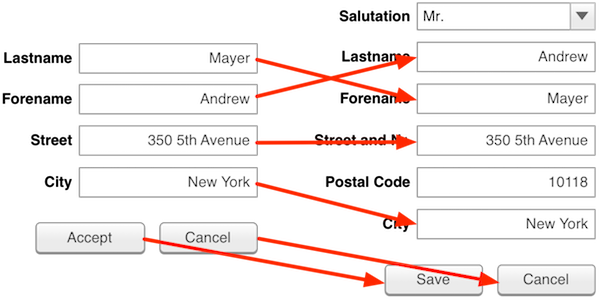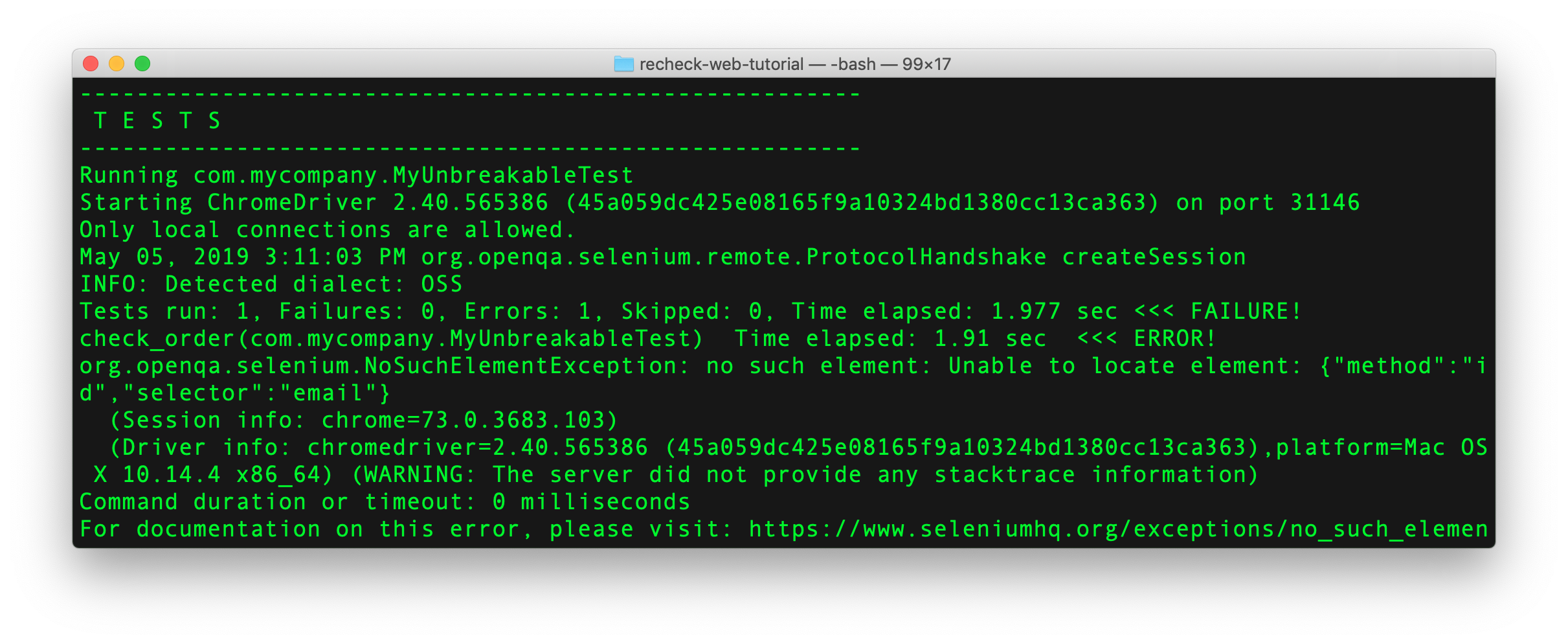Postponing Test Breakage
Element identification is a well-known problem for test automation engineers. recheck addresses this problem in an interesting and unique way. The Golden Master-based Difference Testing approach brings various benefits with it: it basically saves a complete copy of the last working state. Now after a breaking change, that copy can be used as a reference and for comparison. Now, e.g. if the label was used for identification, and the label changed, we can simply have a look in the old version (the Golden Master) and see which element has the given label. Then, using other identifying attributes like its XPath, ID, name, class and others, we can find the corresponding element with a different label in the current state. It is even better: not only do we have redundant information that we can easily keep up to date, thanks to the recheck.cli We also have a much more complete picture, i.e. all other elements that were on the website in the previous state. This allows for an easy 1-on-1 assignment of all elements, enabling a very robust element identification.

To use this functionality, we can simply change an explicit checking test in the following way:
private RecheckDriver driver;
private RecheckWebImpl re;
@Before
public void setUp() {
re = new RecheckWebImpl();
driver = new RecheckDriver( new ChromeDriver() );
}
Now instead of using the regular generic RecheckImpl, we use an adapted RecheckWebImpl and wrap the regular Selenium driver into a special RecheckDriver, that also is an instance of RemoteWebDriver. This way, maximal compatibility to other third party tools and test frameworks is ensured. Next, we can create a test that shows the functionality.
For that we can use an example page from the Selenium project itself. We can download the formPage.html from the Selenium GitHub repository. Save it into your test resources folder (src/test/resources) Let's create a matching test for it. It could look like so:
public class MyUnbreakableTest {
RecheckDriver driver;
@Before
public void setup() {
driver = new RecheckDriver( new ChromeDriver() );
}
@Test
public void check_order() throws Exception {
driver.startTest();
String url = Paths.get( "src/test/resources/formPage.html" ).toUri().toURL().toString();
driver.get(url);
driver.findElement(By.id("email")).sendKeys("Max");
driver.findElement(By.id("age")).sendKeys("16");
driver.findElement(By.name("login")).submit();
driver.capTest();
}
@After
public void tearDown() {
driver.quit();
}
}
Now we execute this test twice (using e.g. mvn test). The first execution will fail as there is no Golden Master to compare against, but recheck will create the Golden Master while doing so. The second time we execute this test, it should pass.
We then want to edit the HTML code of the page and change the used identifiers of the elements the test interacts with. So, we edit the formPage.html file and change the lines 15-19 from
<form method="get" action="resultPage.html" name="login">
<input type="email" id="email"/>
<input type="number" id="age"/>
<input type="submit" id="submitButton" value="Hello there"/>
</form>
to something like
<form method="get" action="resultPage.html" name="newLoginName">
<input type="email" id="userEmail"/>
<input type="number" id="numberOfLifeYears"/>
<input type="submit" id="submit" value="Hello there"/>
</form>
Because these identifiers are used in the test, this would tip of a typical Selenium test and make it fail without an actual problem in the web site-what is usually referred to as "breaking the test". To showcase and verify this problem, we can simply change the used driver to the default ChromeDriver and comment out the recheck-specific capTest() method call (using //). Executing this test with a quick mvn test -Dtest=MyUnbreakableTest results in the dreaded NoSuchElementException.

Now let's redo this with our original test using the RecheckDriver and execute it. It will still fail, but this time due to differences in the checks (as you would expect) and not due to elements not being found anymore. You can verify this by simply ignoring all differences. To do so, edit the .retest/recheck.ignore file and add attribute-regex=.*. This will ignore all attribute changes, including changes to id and name. If you re-execute your test, it will now pass.
However, if you have a closer look to the log output that is printed to the console during execution, you can see that it will now contain a message similar to the following:
*************** recheck warning ***************
The HTML name attribute used for element identification changed from 'login' to 'newLoginName'.
retest identified the element based on the persisted Golden Master.
If you apply these changes to the Golden Master , your test retest.first.steps.FirstOrderTest will break.
Use `By.name("newLoginName")` or `By.retestId("form-26008")` to update your test FirstOrderTest.java:30.
This means that the RecheckDriver caught the NoSuchElementException. It then loaded the persisted Golden Master and found the element within it on the basis of the old version. Then it created the 1-on-1 assignment as shown above. It was able to correctly associate the new with the old element, used this new element in the test and continued. If you now apply that change to the Golden Master, recheck will no longer be able to identify the element based on the outdated identification criteria so you have to update your test when you apply the change.